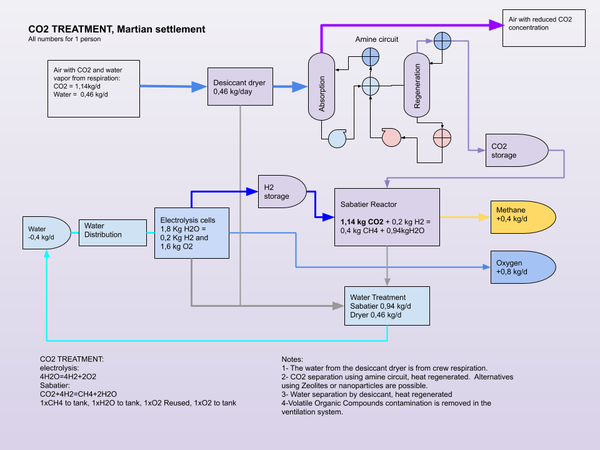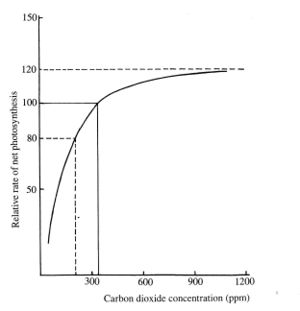Difference between revisions of "Carbon dioxide"
m (→Production) |
|||
| Line 13: | Line 13: | ||
==Settlement atmosphere== | ==Settlement atmosphere== | ||
[[File:Colony CO2 treatment.png|thumb|600x600px]] | [[File:Colony CO2 treatment.png|thumb|600x600px]] | ||
| − | Carbon dioxide is required in the [[Air|settlement atmosphere]] for plant metabolism. Standard concentration on Earth is increasing, so the value is a moving target. However, a concentration between 300ppm (0,03%) and 1000ppm (0,1%) is considered acceptable<ref>Carbon dioxyde concentrations<nowiki/>https://www.nap.edu/read/11170/chapter/5</ref>. Nuclear submarines have varying carbon monoxide levels that can reach 9000 ppm in normal operations. | + | Carbon dioxide is required in the [[Air|settlement atmosphere]] for plant metabolism. Standard concentration on Earth is increasing, so the value is a moving target. However, a concentration between 300ppm (0,03%) and 1000ppm (0,1%) is considered acceptable<ref>Carbon dioxyde concentrations<nowiki/>https://www.nap.edu/read/11170/chapter/5</ref>. Nuclear submarines have varying carbon monoxide levels that can reach 9000 ppm in normal operations. A CO<sub>2</sub> enriched environment may be beneficial for the growth of plants in [[greenhouse|greenhouses]] or [[photobioreactor|photobioreactors]]. |
| − | The Sabatier process can be used in place of photosynthesis to complete the atmospheric part of the carbon cycle. | + | The Sabatier process can be used in place of photosynthesis to complete the atmospheric part of the carbon cycle. [[Bioreactor#Methanotrophs|Methanotrophic]] synthesis of carbohydrates from [[methane]] would be required to complete the carbon metabolic cycle without the use of plants. Or food can be supplied from Earth or Mars for a partial cycle, where [[Methane]] from the Sabatier process can be stored for use as a propellant. |
==Concentration== | ==Concentration== | ||
Revision as of 01:41, 26 July 2020
Carbon dioxide[1] (chemical formula: CO2) is a chemical substance that occupies about 96 % of the Martian atmosphere.
Molar Mass of 12(C)+32(O2)=44
Contents
Biological significance
The metabolism of human beings, animals and various microbes depends on the oxidation of carbohydrates, resulting in carbon dioxide and water exhalation. Plants use the carbon from carbon dioxide to produce carbohydrates and release the oxygen back to the atmosphere, completing the cycle.
- The reaction is: CO2(carbon dioxide) + 2H2O (water) + photons (light energy) → C(n)H2O(m) (carbohydrate) + O2(oxygen)+ H2O (water)[2]
Production
CO2 will be extracted in-situ by atmospheric processing, or from carbonate rocks to provide larger industrial quantities to feed industry[3]
Settlement atmosphere
Carbon dioxide is required in the settlement atmosphere for plant metabolism. Standard concentration on Earth is increasing, so the value is a moving target. However, a concentration between 300ppm (0,03%) and 1000ppm (0,1%) is considered acceptable[4]. Nuclear submarines have varying carbon monoxide levels that can reach 9000 ppm in normal operations. A CO2 enriched environment may be beneficial for the growth of plants in greenhouses or photobioreactors.
The Sabatier process can be used in place of photosynthesis to complete the atmospheric part of the carbon cycle. Methanotrophic synthesis of carbohydrates from methane would be required to complete the carbon metabolic cycle without the use of plants. Or food can be supplied from Earth or Mars for a partial cycle, where Methane from the Sabatier process can be stored for use as a propellant.
Concentration
Concentration of CO2 on Earth is about 400 ppm. Increasing concentration improves plan production rates, however the effect is non linear and reaches a peak of 20% improvement in yields at about 1200 ppm.[5]
Uses
- Photosynthesis by plants in greenhouses to create carbohydrates for plant metabolism.
- Synthetic materials, hydrocarbons using the Fischer Tropsch reaction process.
- Propellant production. Methane (CH4) and Oxygen (O2), through ISRU using the Sabatier process. The hydrogen comes from Electrolysis of water or is brought from Earth.
- Carbon using the Bosch reaction process. The Bosch reaction consumes hydrogen to produce carbon and water. The hydrogen can come from electrolysis of water.
References
- ↑ https://en.wikipedia.org/wiki/Carbon_dioxide
- ↑ Photosynthesis- https://en.wikipedia.org/wiki/Photosynthesis
- ↑ https://www.nature.com/articles/ngeo971
- ↑ Carbon dioxyde concentrationshttps://www.nap.edu/read/11170/chapter/5
- ↑ University of California, Agriculture and Natural ressources https://ucanr.edu/blogs/NurseryFlower/








